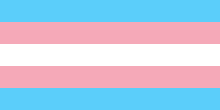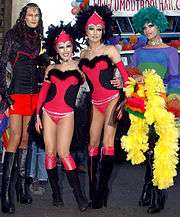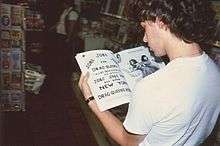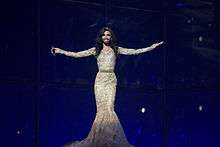Drag queen

| Part of a series on |
| Transgender topics |
|---|
 |
| Identities |
| Topics |
| Attitudes |
| Legal issues |
| Lists |
|
|
| Cross-dressing |
|---|
| History of cross-dressing |
| Key elements |
| Modern drag culture |
| Sexual aspects |
|
Sexual attraction to cross-dressers |
| Other aspects |
| Passing as male |
| Passing as female |
| Organizations |
| Books |
A drag queen is a person, usually male, who dresses in drag and often acts with exaggerated femininity and in feminine gender roles. Often, they will exaggerate certain characteristics such as make-up and eyelashes for comic, dramatic, or satirical effect. While drag is very much associated with gay men and gay culture, there are drag artists of all sexualities and gender identities. There are many kinds of drag artists and they vary greatly in dedication, from professionals who have starred in films to people who just try it once, or those who simply prefer clothing and makeup that is usually worn by the opposite sex in their culture. Drag queens can vary widely by class and culture. Other drag performers include drag kings, women who perform in male roles and attire, faux queens, who are women who dress in an exaggerated style to emulate drag queens, and faux kings, who are men who dress to impersonate drag kings.
There are many reasons people do drag including self-expression, comfort, transvestic fetishism, and spiritual reasons, as well as the higher-profile performing and entertaining. Drag can be a creative outlet, a means of self-exploration, and a way to make cultural statements. While the general public may be most familiar with the "high drag" of professional performance artists, drag is also part of regular life and street culture for many gender-nonconforming or gender-variant people, who may or may not consider what they do, "drag." Drag queen activities among stage and street performers may include lip-synching performances, live singing, dancing, participating in events such as gay pride parades, drag pageants, or at venues such as cabarets and discotheques. Some drag artists also engage in mix-and-mingle or hosting work in night clubs, such as drag bingo, and at private parties and events. Famous drag queens include Rupaul, Divine, Dame Edna Everage, Lily Savage, Lady Bunny, Shannel, Alaska 5000, Bianca Del Rio, Raven (drag queen), Raja Gemini, Jinkx Monsoon, Sharon Needles, Willam, Violet Chachki, Alyssa Edwards, Shangela Laquifa Wadley, Manila Luzon, Courtney Act, Pearl Liaison, Jackie Beat, Adore Delano, Tyra Sanchez, Trixie Mattel, Katya Zamolodchikova, Naomi Smalls, Kim Chi, Bob the Drag Queen, Thorgy Thor, Acid Betty, Conchita Wurst, Kleo Torrez and Chad Michaels.
Terminology
Drag queen
The etymology of the term "drag queen" is disputed. The term drag queen occurred in Polari, a subset of English slang that was popular in some gay communities in the early part of the 20th century. Its first recorded use to refer to actors dressed in women's clothing is from 1870.[1]
A folk etymology is that drag is an acronym of "Dressed Resembling A Girl" in description of male theatrical transvestism. The film Connie and Carla also made a reference to this, though the acronym was slightly altered to men "DRessed As Girls".
Queen may refer to the trait of affected royalty found in the personalities of many who do drag (whether this is their normal personality or a character created for the stage). It is also related to the Old English word "quean" or cwene, which originally simply meant "woman", then was later used as a label both for promiscuous women and gay men (see Oxford English Dictionary definition number 3 for "queen"). The OE word apprears derived from Middle Dutch quene ("old woman"), ultimately from Proto-Germanic *kwenǭ ("woman"), from Proto-Indo-European *gʷḗn ("woman").
Drag as a term referring to women's clothing worn by men has less clear origins. According to one theory, it was used in reference to transvestites at least as early as the 18th century, owing to the tendency of their skirts to drag on the ground. Another possibility is that it derives from the Romani word for skirt, which appears in a number of Romani dialects of Northern Europe with forms like daraka and jendraka.[2]
Female impersonator
Another term for a drag queen, female impersonator,[3] is still used—though it is sometimes regarded as inaccurate, because not all contemporary drag performers are attempting to pass as women. Female impersonation has been and continues to be illegal in some places, which inspired the drag queen José Sarria to hand out labels to his friends reading, "I am a boy," so he could not be accused of female impersonation.[4] American drag queen RuPaul once said, "I do not impersonate females! How many women do you know who wear seven-inch heels, four-foot wigs, and skintight dresses?" He also said, "I don't dress like a woman; I dress like a drag queen!".
Celebrity drag couple "The Darling Bears" go so far as to sport full beards for their performances, which could also be referred to as genderfuck. Going in drag while retaining clearly masculine features is referred to as skag drag.
Some performers draw the distinction that a female impersonator seeks to emulate a specific female star or celebrity, while a drag queen only seeks to create a distinctive feminine persona of his or her own.
Drag and transvestism

Drag queens are sometimes called transvestites, although that term also has many other connotations than the term "drag queen" and is not much favored by many drag queens themselves. This is because of the distinctions between drag queens and transvestic fetishists. "Drag queen" usually connotes cross-dressing for the purposes of entertainment and self-expression. It is not an accurate way to describe people who cross-dress for the fulfillment of transvestic fetishes alone, i.e. people whose cross-dressing is primarily part of a private sexual activity or identity. Those whose motivation for transvestism is not primarily sexual, and who may go about their daily lives cross-dressed, often do not adopt the over-the-top drag queen look, at least not for daily wear; these individuals may or may not self-identify as drag queens.
Alternative terms
There are also performers who prefer to be called "gender illusionists" who do blur the line between transgender and drag queen. Generally transgender performers do not consider themselves to be drag queens and drag queens don't consider themselves to be illusionists, but, as with everything, there are exceptions. Often these distinctions are more generational, as laws and acceptance of individuality change and grow.
Many drag queens prefer to be referred to as "she" while in drag and desire to stay completely in character. Some performers object to being referred to as "he" or by their legal name while in character. Drag performer RuPaul is an exception, as he seems to be completely indifferent to which pronoun is used to refer to him. In his words, "You can call me he. You can call me she. You can call me Regis and Kathie Lee; I don't care!"[5]
The term tranny has been embraced by drag performers, notably RuPaul,[6] and the gay male community[7] in the United States, but it is considered offensive to most transgender and transsexual people.[8] In the transgender community, it is taken as a degrading term along the lines of the highly offensive words "fag" and "faggot" in gay communities. This has caused the usage of the term to diminish.
Drag and theater
Men performing as women was mandated in early theater. Women were not allowed to perform on stage. In England, the first recorded appearance of a woman on the professional stage in an English troop did not occur till the year 1660.[9]
In Shakespeare's plays, men in female dress played the role of 14 different queens. The first Juliets in Romeo and Juliet were likely boys or young men. Cross-dressing was a common theme in Shakespeare's plays. In As You Like It, one of his most popular plays, a boy cross-dressed as a girl would have played the role of Rosalind. In the play, Rosalind appears in drag dressed as Ganymede. In turn the character Ganymede dresses as a girl to help a boy who tries to woo Rosalind. Therefore, early theater goers would have watched a boy actor who dresses as a girl, then dresses as a boy, who then dresses as a girl. At the play's end the boy actor appears dressed as a girl. This is echoed in the musical comedy film Connie and Carla where the title characters are "women dressed as men, dressed as women".
Drag queen names

There are various types of drag names. Many fall into two categories: The first are satirical names that play on words, such as Miss Understood, Gia Gunn, Ginger Minj, Sharon Needles and Lypsinka. A subset of this type of name is the name that at first glance may seem like a simple female name, but upon second look or hearing is a pun on a female, often erotic, body part. For example, Kleo Torrez - which is meant to sound like the female erogenous zone.
The second type are names that trend toward glamour and extravagance, such as Dame Edna Everage, Chi Chi LaRue, Violet Chachki, Fabulous Russella, Miss Fame, The Lady Chablis, BeBe Zahara Benet and Zsa Zsa Shakespeer. This is the type used by the character Albin in the movie and musical La Cage Aux Folles for his drag persona, "Miss ZaZa Napoli".
Other types can have an in-depth backstory, cultural or geographical significance or simply be a feminine form of their "male" name. Some examples of these varieties include Verka Serduchka, Raja Gemini, Miss Coco Peru, Shequida, Betty Butterfield, Jinkx Monsoon and Divine. A few drag queens, including RuPaul, Willam and Craig Russell have also used part or all of their own male names when performing in drag.
In some cases drag queens will get their (drag) last name from the house they belong to, such as the House of Xtravaganza.
A drag queen may either pick or be given a drag name by a friend or "drag mother". While some may keep using the same drag name, drag queens do change names as well even using two or more concurrently for various reasons.
Art of drag

The process of getting into drag or into character can take hours. A drag queen may aim for a certain style, celebrity impression, or message with their look. Hair, make-up, and costumes are the most important essentials for drag queens.[10]
As a form of art, much work and creativity is put into transforming into a drag queen. Applying makeup is essential in order to achieve a more feminine look.[11] Foundation helps to create a clean canvas by covering all wrinkles, flaws, and blemishes.[12] Once the clean canvas is created, eye shadow[13] will be added to eyes for a dramatic look. Drag queens use a lot of eyelashes to give the eyes a more intense look. Layering different colors of eye shadows, bronzers, and blush is used in creating the finished face of a drag queen. Since most drag queens are men, contouring[14] is very important in creating high cheekbones and a slimmer face, as well as creating a smaller structured nose. Many drag queens often wear wigs or hairpieces. A costume is also needed. Depending on the event and the look that each drag queen is going for, the costumes can consist of, for example, a sparkling sequined dress, a leopard body suit, or a fur coat.[15] Drag queens tend to go for a more exaggerated look with a lot more makeup than a typical feminine woman would wear.
With the complete look, drag queens often go out to clubs and bars, where they will typically perform an act which is called a "drag show."[16] Many drag queens do dress up for money by doing different shows, but there are also drag queens that have full-time jobs but still enjoy dressing up in drag as a hobby.[17]
Many parts of the drag show, and of the drag queens’ other intellectual properties, cannot be protected by intellectual property law. To substitute the lack of legal protection, drag queens revert to social norms in order to protect their intellectual property.[18]
Drag shows and venues

A drag show is an entertainment consisting of a variety of songs, monologues or skits featuring either single performers or groups of performers in drag meant to entertain an audience. They range from amateur performances at small bars to elaborately staged theatrical presentations. Many drag shows feature performers singing or lip-synching to songs while performing a pre-planned pantomime, or dancing. The performers often don elaborate costumes and makeup, and sometimes dress to imitate various famous female singers or personalities. And some events are centered around drag, such as Southern Decadence where the majority of festivities are led by the Grand Marshals, who are traditionally drag queens.[19] In most cases, you can see drag performance at bars without any cost, but there are other drag queen performances where purchasing tickets is required. Tipping is usually encouraged.
In movies
- 1937 – Upstairs (film) (Piętro wyżej), first drag queen style movie, starring Eugeniusz Bodo
- 1953 – Glen or Glenda, one of the most famous cult classics of Ed Wood, starring himself as Glen and Glenda.
- 1954 – White Christmas, classic of Irving Berlin, with Danny Kaye and Bing Crosby singing in "drag".
- 1959 – Some Like It Hot, starring Marilyn Monroe, Tony Curtis and Jack Lemmon.
- 1967 – Thoroughly Modern Millie, an American musical starring Julie Andrews, James Fox, Mary Tyler Moore, Carol Channing, John Gavin, and Beatrice Lillie, notable where Fox's character dresses in drag in order to find out what happened to Tyler Moore's character.
- 1969 – Funeral Parade of Roses starring Peter
- 1972 – Pink Flamingos starring Divine
- 1975 – The Rocky Horror Picture Show, with Tim Curry as a cross-dressing bi-sexual, Susan Sarandon, Barry Bostwick
- 1977 – Outrageous!, starring Craig Russell as a fictionalized version of himself
- 1979 – The Rose starring Bette Midler, notable for a scene in which Midler's character Mary Rose Foster performs a duet on stage in a drag club with a drag queen (played by Kenny Sacha) who is impersonating Midler as Foster.
- 1982 – Tootsie starring Dustin Hoffman, Jessica Lange, and Teri Garr
- 1982 – Victor/Victoria starring Julie Andrews
- 1985 – Lust in the Dust starring Divine
- 1988 – Hairspray starring Divine (Remade in 2007 starring John Travolta)
- 1988 – Torch Song Trilogy starring Harvey Fierstein, Anne Bancroft and Matthew Broderick
- 1990 – Paris Is Burning a documentary film directed by Jennie Livingston. It chronicles the ball culture of New York City and the gay and transgender community involved in it. It centers around African American and Latino drag culture surrounding communities such as Harlem in the 80s.
- 1991 – Vegas in Space starring Doris Fish, Miss X, Ginger Quest, and introducing 'Tippi'
- 1993 – Mrs. Doubtfire starring Robin Williams, Sally Field, and Pierce Brosnan.
- 1994 – The Adventures of Priscilla, Queen of the Desert starring Terence Stamp, Hugo Weaving, and Guy Pearce
- 1995 – To Wong Foo, Thanks for Everything! Julie Newmar starring Wesley Snipes, Patrick Swayze, and John Leguizamo (cameo by RuPaul)
- 1995 – Wigstock: The Movie documentary film focusing on the annual drag music festival that had been held in New York City's East Village during the 1980s and 1990s. Includes appearances by Lady Bunny, Crystal Waters, Deee-Lite, Jackie Beat, Debbie Harry, Leigh Bowery, Joey Arias and the Dueling Bankheads. The film also captures a performance by RuPaul at the height of his mainstream fame during the 1990s.
- 1996 – The Birdcage starring Robin Williams, Nathan Lane, Gene Hackman and Dianne Wiest (a remake of the 1978 film La Cage aux Folles, based on the 1973 play)
- 1996 – The Nutty Professor (1996 film) starring Eddie Murphy.
- 1998 – Midnight in the Garden of Good and Evil starring John Cusack, Kevin Spacey and starring as herself Lady Chablis
- 1999 – Flawless starring Philip Seymour Hoffman and Robert De Niro
- 2000 – Big Momma's House starring Martin Lawrence
- 2001 – Hedwig and the Angry Inch starring John Cameron Mitchell
- 2003 – Girls Will Be Girls directed by Richard Day, starring Miss Coco Peru (Clinton Leupp), Evie Harris (Jack Plotnick), and Varla Jean Merman (Jeffery Roberson).
- 2003 – Die, Mommie, Die! starring Charles Busch, Jason Priestly, Philip Baker Hall, and Natasha Lyonne
- 2004 – Connie and Carla starring Nia Vardalos, Toni Collette, and David Duchovny
- 2004 – White Chicks starring Shawn Wayans and Marlon Wayans
- 2005 – Kinky Boots starring Joel Edgerton, Chiwetel Ejiofor, Sarah-Jane Potts, and Nick Frost
- 2005 – Rent
- 2006 – The Curiosity of Chance starring Tad Hilgenbrink and Brett Chukerman
- 2006 – I Wanna Be a Republican starring The Kinsey Sicks, America's Favorite Dragapella Beautyshop Quartet
- 2007 – A Shade Before Pink features cross dressing, drag queens and gender questioning. Starring Cary Woodworth and Rhoda Jordan, guest appearance by Jackie Beat.
- 2007 – St. Trinian's starring Rupert Everett as Camilla Fritton, the headmistress of the school.
- 2008 – Slingbacks and Syrup,[20][21][22][23] a documentary about the House of LeMay that held its world premiere at the Vermont International Film Festival.
- 2009 – Tamid oto chalom, an Israeli TV miniseries about drag life in Tel Aviv, based on the songs of Israeli songwriter Svika Pick
- 2010 – Yazima Beauty Salon the Movie featuring drag comedy/dance group Yazima Beauty Salon
- 2011 – Big Mommas: Like Father Like Son starring Martin Lawrence and Brandon T. Jackson
- 2012 - Albert Nobbs starring Glenn Close and Janet McTeer
- 2015 – Dressed As A Girl starring Johnny Woo
- 2016 - Absolutely Fabulous: The Movie starring Joanna Lumley and Jennifer Saunders, featuring Jodie Harsh and La Voix amongst others
- 2016 - Iru mugan (Indian Tamil movie) starring Vikram, Nayanthara, Nithya Menen and Nasser in the lead roles.
- 2016 - Hurricane Bianca starring Bianca Del Rio, Willam Belli, Shangela Laquifa Wadley and appearances by RuPaul, Joslyn Fox and Alyssa Edwards[24]
In music

While some male music celebrities wear exaggerated feminine clothing as part of their show, they are not necessarily drag queens. For example, Boy George wears drag queen style clothes and cosmetics but he once stated he was not a drag queen.[25] RuPaul[26] is a professional drag queen performer.
Examples of songs where lyrics refer to drag queens:
- "Lola" by The Kinks
- "Walk on the Wild Side" by Lou Reed
- "Dude (Looks Like a Lady)" by Aerosmith
- "The Lady is a Vamp" by The Spice Girls
- "Ballad of Cleo and Joe" by Cyndi Lauper
- "King for a Day" by Green Day
- "Cherry Lips" by Garbage
- "Born This Way" by Lady Gaga
- "Verbatim" by Mother Mother
- "He's a Woman She's a Man" by Scorpions
- "Pretty Lady" by Ke$ha & Detox Icunt
- "Andrew in Drag" by The Magnetic Fields
- "Rise Like a Phoenix" by Conchita Wurst (Represented Austria at the 2014 Eurovision Song Contest and won)
- "Divine" by Antony and the Johnsons
- "World Top" by Bear Trap
- "The End." in the album The Black Parade by My Chemical Romance
- "Drag Queen" by The Strokes
Genres
- Low camp drag queens employ a drag aesthetic based on clown-like values like exaggeration, satire, and ribaldry. Divine, Miss Understood, Peaches Christ, Bianca Del Rio, and Hedda Lettuce can be considered examples of camp queens. High camp drag embodies female impersonation and realism.
- Some drag queens exaggerate in the dimension of elegance and fashion, employing elaborate jewelry and gowns. The Lady Chablis, who can be seen in the movie Midnight in the Garden of Good and Evil is an example of this type of performer. Many of these drag queens impersonate specific actresses and pop divas such as Cher, Britney Spears, Bette Midler, Madonna, Gilla, Charo, Connie Francis, Donna Summer, Whitney Houston, Mariah Carey, Céline Dion, Diana Ross, Tina Turner, Patti LaBelle, Shirley Bassey, Janet Jackson, Spice Girls, Lady Gaga and others, emulating their high-fashion costuming and jewelry. Drag artist John Epperson has used the persona Lypsinka as a caricature of Joan Crawford, including in his play The Passion of the Crawford.

- Some drag queens primarily perform in pageants, hence the term pageant queen. Pageant queens gear their act toward winning titles and prizes in various contests and pageant systems. Some of these have grand prizes that rival those of pageants such as Miss America; see drag pageantry. These drag queens can be known nationally and many work professionally year-round producing and hosting shows that specialize in drag and celebrity illusionists.
- Post-modernist drag queens, tranimal, or "terrorist drag" mixes performance art, punk rock, racial and social issues into drag. The drag queens often purposely use unkempt wigs and clothing. Sharon Needles, Vaginal Davis and Christeene Vale are examples of "drag terrorists."[27] Davis' performances have been described as a reaction against the "conservative politics of gay culture."[28] Likewise, David Hoyle describes himself as an "anti-drag queen" in his use self-harm to parody what he views as materialism and hedonism within the gay community.[29] Tranimal drag also breaks conventional ways of dressing like a woman by taking influences from Leigh Bowery and the Cockettes.[30][31] Similarly, "Genderfuck" drag is a kind of drag that explicitly blurs the lines between gender boundaries, with queens like Milk (Dan Donigan) embodying this philosophy.[32]
- Starting in the late 20th century, groups of drag queens have come together under a unifying identity and shtick to perform a charitable and/or activist function in their communities. Some perform to raise funds for other charities, LGBT and other, while others protest for LGBT and Civil rights. These groups include The West Hollywood Cheerleaders, the Imperial Court System founded by The Widow Norton (José Sarria), and The Sisters of Perpetual Indulgence. Some of these groups, such as the Sisters, perform a quasi-spiritual function or act as social counselors, consciously reviving the ancient archetype of historical drag queens as shamans and spiritual functionaries. The common practice and aesthetic here is flamboyance in service.
Societal reception
Drag has come to be a celebrated aspect of modern gay life.[33] Many gay bars and clubs around the world hold drag shows as special parties. Several "International Drag Day" holidays have been started over the years to promote the shows. In the U.S. drag is typically celebrated in early March.
A televised drag competition, RuPaul's Drag Race, is the most successful program on the Logo television network. In 2016, RuPaul's Drag Race won an Emmy award for "Outstanding Host for a Reality or Reality-Competition Program."[34] However, its winners and contestants have yet to receive the same level of recognition as mainstream reality show contestants.
Within the larger lesbian, gay, bisexual, transgender (LGBT) community, drag queens are sometimes criticized for their participation in pride parades and other public events, believing that this projects a limited and harmful image of gay people and impedes a broader social acceptance. This attitude itself is criticized for limiting self-expression and encouraging the idea that there are "right" and "wrong" ways to be gay. In more recent years drag queens have been prominently featured at these same events.
A common criticism of drag queens is that they promote negative stereotypes of women, comparable to blackface (a racially offensive portrayal of African Americans by white performers that was popular throughout the 19th to early 20th century). Conversely, some feminists embrace drag as a skewering of traditional gender roles, defying the social norms of male and female appearance and behaviour and showing the artificiality of femininity and masculinity.
Drag queens are sometimes criticized by members of the transgender community — especially, but not exclusively, by many trans women — because of fears that they themselves may be stereotyped as drag queens. For example, the late Star Maris, a Canadian transgender activist, wrote a song entitled "I'm Not A Fucking Drag Queen" which expresses her frustration and hurt at being mistaken for a drag queen. The song was featured in the film Better Than Chocolate, performed by a trans woman on stage at a gay club. The transgender character, played by Peter Outerbridge, struggles throughout the movie to fit in with cisgender women, and performs the song partially as an act of cathartic defiance and self-empowerment. Other trans women reject those criticisms in the broader context that drag queens, many of whom are gender-variant and sexuality minorities, are more of an ally for the cause of recognition and equality.
See also
| Wikimedia Commons has media related to Drag queen. |
- Ball culture
- Cover Girl
- Cross-dressing
- Drag pageantry
- Finocchio's Club
- Imperial Court System
- Kiki DuRane
- List of drag queens
- List of transgender-related topics
- Pansy Craze
- Sisters of Perpetual Indulgence
- Stonewall riots
- The Pink Mirror, a film on Indian drag queens
- Tootsie
- Vegas in Space
- Wanda Wisdom
Notes
- ↑ Felix Rodriguez Gonzales (2008). "The feminine stereotype in gay characterization: A look at English and Spanish". In María de los Ángeles Gómez-González; María A. Gómez-González; J. Lachlan Mackenzie; Elsa González Álvarez. Languages and cultures in contrast and comparison. John Benjamins Publishing Company. p. 231. ISBN 9789027254191.
- ↑ http://romani.uni-graz.at/romlex/lex.cgi?st=skirt&rev=y&cl1=roml&cl2=en&fi=&pm=pr&ic=y&im=y&wc=
- ↑ When Cross Dressing was a crime http://www.advocate.com/arts-entertainment/books/2015/03/12/tbt-when-cross-dressing-was-crime?page=full
- ↑ ">> social sciences >> Sarria, José". glbtq. 1923-12-12. Retrieved 2014-03-01.
- ↑ Rupaul (June 1995), Lettin' It All Hang Out: An Autobiography, Hyperion Books
- ↑ Spargo, Chris (2012-01-15). "NEW: RuPaul's 'Tranny' Conroversy". NewNowNext. Retrieved 2013-10-06.
- ↑ Musto, Michael (2010-11-12). "Is "Tranny" So Bad?". Blogs.villagevoice.com. Retrieved 2013-10-06.
- ↑ "Is 'Tranny' Offensive?". The Bilerico Project. 2008-09-09. Retrieved 2013-10-06.
- ↑ {{Cite: Mabillard, Amanda. Shakespeare: General Q & A Shakespeare Online . 20 Aug. 2000.< http://www.shakespeare-online.com/faq/womenonstage.html>.}}
- ↑ "Dude to Diva: How to Become a Drag Queen | The Chronicle". Dukechronicle.com. Retrieved 2014-03-01.
- ↑ Simple Everyday Makeup https://www.youtube.com/watch?v=gufRvEQzDRs
- ↑ Quick Makeup Foundation Tutorial https://www.youtube.com/watch?v=J_fk6id1Wrg
- ↑ How to Apply Smokey eye Makeup https://www.youtube.com/watch?v=IBxrLfeWpUk
- ↑ How to Highlight and Contour your Face https://www.youtube.com/watch?v=DHdGsdU7BIw
- ↑ "Drag Queen Transformation – Rodd becomes Patti". YouTube. Retrieved 2014-03-01.
- ↑ King, Mark. "A working life: the drag queen | Money". The Guardian. Retrieved 2014-03-01.
- ↑ "Tom Bartolomei: 10 Myths About Drag Queens". Huffingtonpost.com. 2013-04-01. Retrieved 2014-03-01.
- ↑ Sarid, Eden (2014). "Don't Be a Drag, Just Be a Queen - How Drag Queens Protect their Intellectual Property without Law". Florida International University Law Review. 10 (1). Retrieved 8 April 2016.
- ↑ "Southern Decadence Official Website". Southerndecadence.net. 2013-09-03. Retrieved 2014-03-01.
- ↑ "Burlington Beauties, Erin Trahan, New England Film, January 1, 2009". Newenglandfilm.com. Retrieved 2014-03-01.
- ↑ Bourne, Kay (2008-12-03). "Edge, Boston, MA, December 3, 2008". Edgeboston.com. Retrieved 2014-03-01.
- ↑ VTIFF Website, 2008. Archived October 18, 2014, at the Wayback Machine.
- ↑ James, Megan. "VIFF Moves to Palace 9, Seven Days, October 15, 2008". 7dvt.com. Retrieved 2014-03-01.
- ↑ http://www.imdb.com/title/tt4007248/fullcredits?ref_=tt_ov_st_sm
- ↑ "Boy George: "I'M Not A Dragqueen!" At Youtube". Youtube.com. 2007-12-27. Retrieved 2014-03-01.
- ↑ Rupaul Biography Drag Queen Diaries
- ↑ Weathers, Christeene. "Christeene by Chelsea Weathers". Art Lies. Retrieved 9 March 2013.
- ↑ Johnson, Dominic. "Vaginal Davis' Biography". VaginalDavis.com. Retrieved 9 March 2013.
- ↑ Walters, Ben (24 March 2010). "Welcome back David Hoyle: you're a divine director". The Guardian. Retrieved 9 March 2013.
- ↑ Shellhammer, Bradford (27 December 2010). "jer ber jones (Bradford Shellhammer : Interviews)". BradfordShellhammer.com. Retrieved 23 March 2013.
- ↑ Romano, Tricia (1 December 2009). "How to Become a Tranimal". BlackBook. Retrieved 23 March 2013.
- ↑ Milk - Bio.
- ↑ Sarid, Eden (2014). "Don 't Be a Drag, Just Be a Queen—How Drag Queens Protect their Intellectual Property without Law". Florida International University Law Review. 10 (1): 142.
- ↑ "RuPaul's Drag Race". Television Academy. Retrieved 2016-09-28.
External links
| Look up female impersonator in Wiktionary, the free dictionary. |
| Look up drag queen in Wiktionary, the free dictionary. |
- Drag Social Network, community and portal
- Drag Artist Discography (information and discography with historical references and photos) of drag artists & female impersonators
- The Pink Mirror – a film on Indian drag queens
- Queens of Las Vegas drag show
- International Drag Queens and Friends
